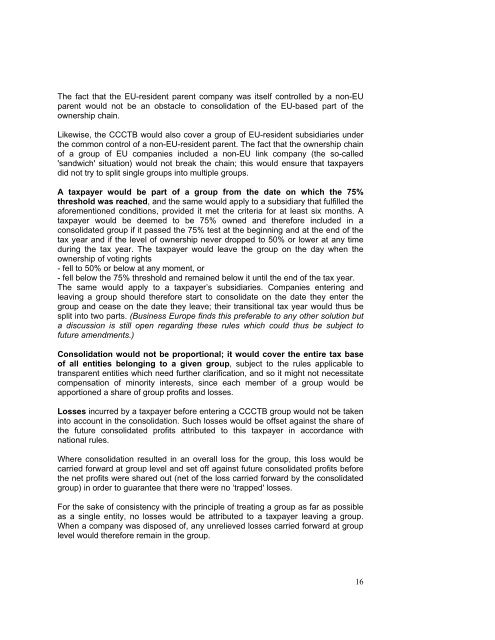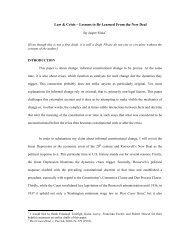An outline of the CCCTB (Common Consolidated Corporate Tax ...
An outline of the CCCTB (Common Consolidated Corporate Tax ...
An outline of the CCCTB (Common Consolidated Corporate Tax ...
You also want an ePaper? Increase the reach of your titles
YUMPU automatically turns print PDFs into web optimized ePapers that Google loves.
The fact that <strong>the</strong> EU-resident parent company was itself controlled by a non-EU<br />
parent would not be an obstacle to consolidation <strong>of</strong> <strong>the</strong> EU-based part <strong>of</strong> <strong>the</strong><br />
ownership chain.<br />
Likewise, <strong>the</strong> <strong>CCCTB</strong> would also cover a group <strong>of</strong> EU-resident subsidiaries under<br />
<strong>the</strong> common control <strong>of</strong> a non-EU-resident parent. The fact that <strong>the</strong> ownership chain<br />
<strong>of</strong> a group <strong>of</strong> EU companies included a non-EU link company (<strong>the</strong> so-called<br />
'sandwich' situation) would not break <strong>the</strong> chain; this would ensure that taxpayers<br />
did not try to split single groups into multiple groups.<br />
A taxpayer would be part <strong>of</strong> a group from <strong>the</strong> date on which <strong>the</strong> 75%<br />
threshold was reached, and <strong>the</strong> same would apply to a subsidiary that fulfilled <strong>the</strong><br />
aforementioned conditions, provided it met <strong>the</strong> criteria for at least six months. A<br />
taxpayer would be deemed to be 75% owned and <strong>the</strong>refore included in a<br />
consolidated group if it passed <strong>the</strong> 75% test at <strong>the</strong> beginning and at <strong>the</strong> end <strong>of</strong> <strong>the</strong><br />
tax year and if <strong>the</strong> level <strong>of</strong> ownership never dropped to 50% or lower at any time<br />
during <strong>the</strong> tax year. The taxpayer would leave <strong>the</strong> group on <strong>the</strong> day when <strong>the</strong><br />
ownership <strong>of</strong> voting rights<br />
- fell to 50% or below at any moment, or<br />
- fell below <strong>the</strong> 75% threshold and remained below it until <strong>the</strong> end <strong>of</strong> <strong>the</strong> tax year.<br />
The same would apply to a taxpayer’s subsidiaries. Companies entering and<br />
leaving a group should <strong>the</strong>refore start to consolidate on <strong>the</strong> date <strong>the</strong>y enter <strong>the</strong><br />
group and cease on <strong>the</strong> date <strong>the</strong>y leave; <strong>the</strong>ir transitional tax year would thus be<br />
split into two parts. (Business Europe finds this preferable to any o<strong>the</strong>r solution but<br />
a discussion is still open regarding <strong>the</strong>se rules which could thus be subject to<br />
future amendments.)<br />
Consolidation would not be proportional; it would cover <strong>the</strong> entire tax base<br />
<strong>of</strong> all entities belonging to a given group, subject to <strong>the</strong> rules applicable to<br />
transparent entities which need fur<strong>the</strong>r clarification, and so it might not necessitate<br />
compensation <strong>of</strong> minority interests, since each member <strong>of</strong> a group would be<br />
apportioned a share <strong>of</strong> group pr<strong>of</strong>its and losses.<br />
Losses incurred by a taxpayer before entering a <strong>CCCTB</strong> group would not be taken<br />
into account in <strong>the</strong> consolidation. Such losses would be <strong>of</strong>fset against <strong>the</strong> share <strong>of</strong><br />
<strong>the</strong> future consolidated pr<strong>of</strong>its attributed to this taxpayer in accordance with<br />
national rules.<br />
Where consolidation resulted in an overall loss for <strong>the</strong> group, this loss would be<br />
carried forward at group level and set <strong>of</strong>f against future consolidated pr<strong>of</strong>its before<br />
<strong>the</strong> net pr<strong>of</strong>its were shared out (net <strong>of</strong> <strong>the</strong> loss carried forward by <strong>the</strong> consolidated<br />
group) in order to guarantee that <strong>the</strong>re were no ‘trapped' losses.<br />
For <strong>the</strong> sake <strong>of</strong> consistency with <strong>the</strong> principle <strong>of</strong> treating a group as far as possible<br />
as a single entity, no losses would be attributed to a taxpayer leaving a group.<br />
When a company was disposed <strong>of</strong>, any unrelieved losses carried forward at group<br />
level would <strong>the</strong>refore remain in <strong>the</strong> group.<br />
16
















